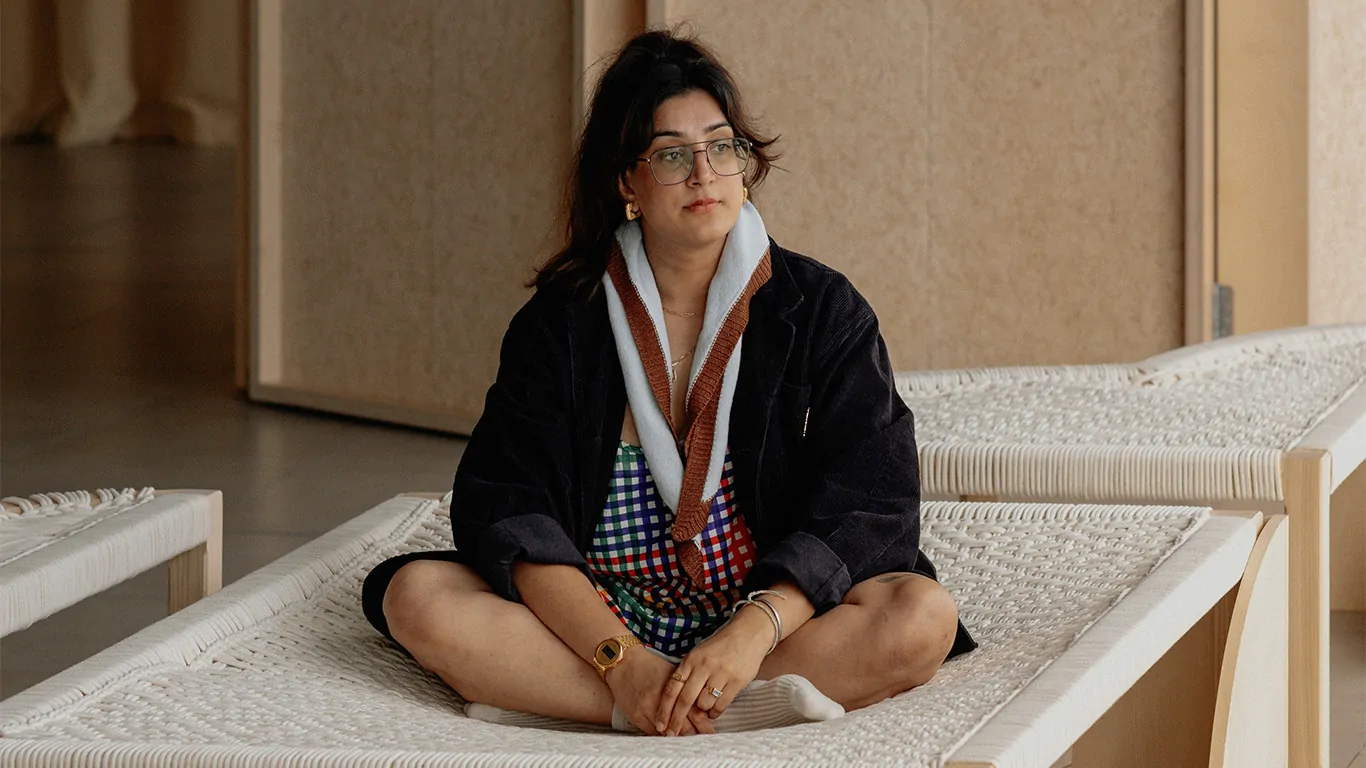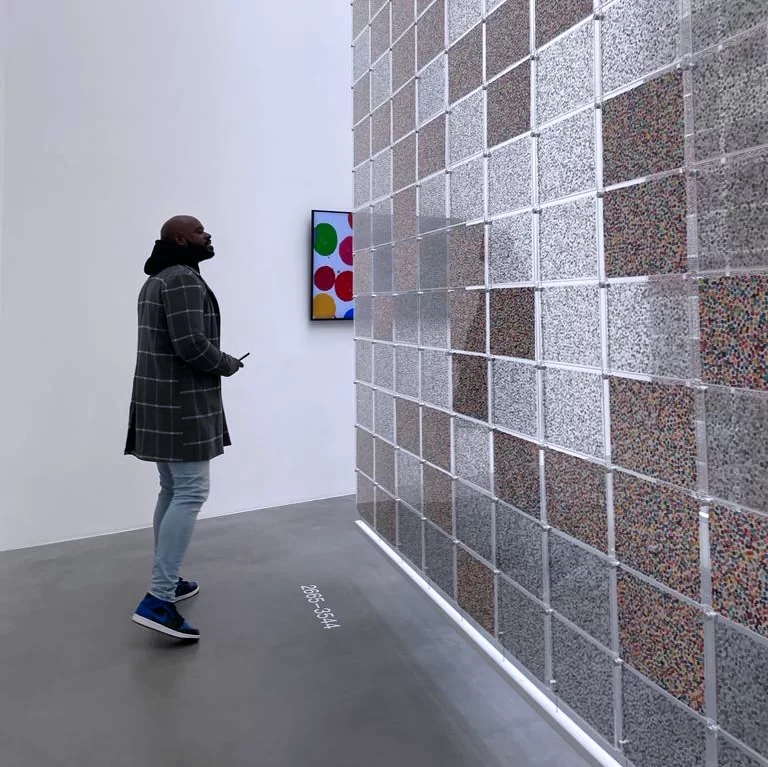Roo Dhissou, the Birmingham-based artist and researcher, builds worlds of care one table at a time, weaving South Asian cultural practices into contemporary debates on identity, belonging and institutional responsibility.
Roo Dhissou is a Birmingham-based British Asian multidisciplinary artist and researcher whose practice spans craft, cooking, performance and installation. Rooted in community, diaspora and personal histories, her work often draws on South Asian cultural practices – from the communal Sikh langar thali to folk songs and the medicinal knowledge of herbs and spices – to ask how identity is formed, sustained and repaired, while probing the ethics of care in both community and institutional contexts.
Currently completing a practice-led PhD at Birmingham City University, Cultural Dysphoria: British South Asian Women Artists Beyond Binaries, Dhissou insists that theory and practice remain inseparable. “The research and the studio are the same conversation held in different rooms,” she says. At the core of this inquiry is her notion of “cultural dysphoria”, which contrasts with the more familiar idea of hybridity. Where hybridity implies a neat fusion, dysphoria reflects the uneven, embodied experience of belonging and estrangement — “a barometer,” she says, “that points to the frictions from which repair can begin.”
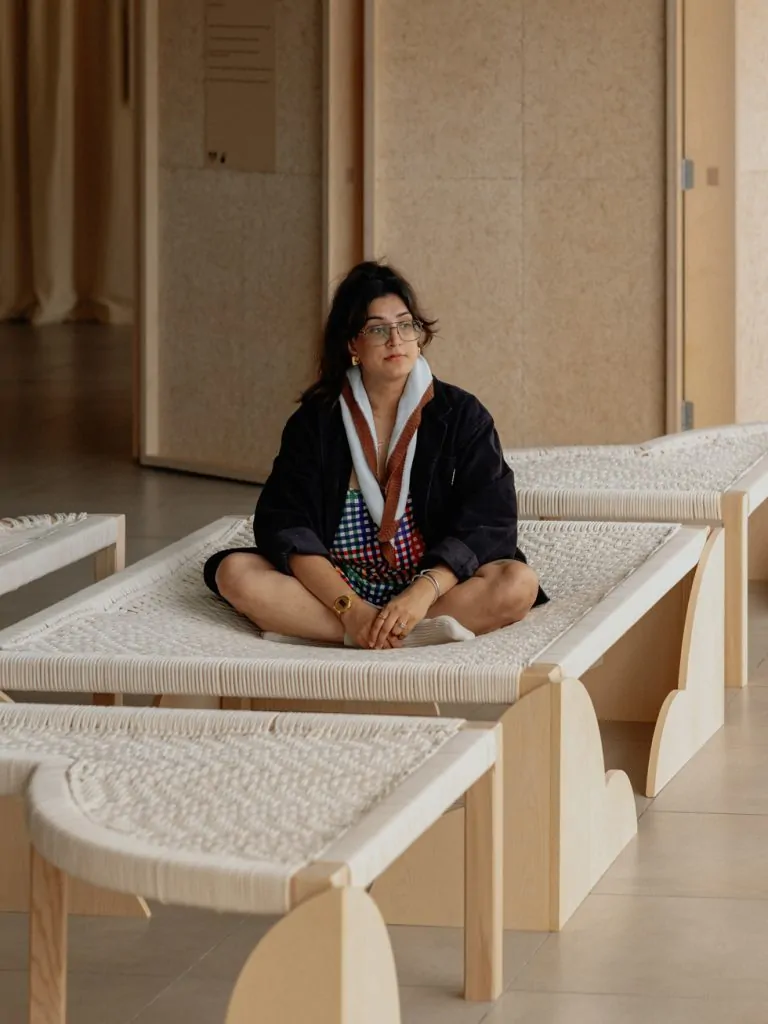
Photo by Taran Wilkhu
Courtesy without SHAPE without FORM
Writing lets me test language for experiences that are messy, relational and sometimes inarticulate. Making lets me test those ideas
with the body, with materials, with time and with other peopleRoo Dhissou
Repair, hospitality and collective responsibility are central to her practice. In projects such as Courses for Dis-Course(s) she has used handmade thalis, woven beds and tea trolleys to host conversations among British South Asian women and non-binary artists. These objects, she stresses, are not props but working tools: “Cooking teaches timing, listening and trust. Craft trains attention, patience and repair. Care is not decoration; it is infrastructure.”
Her recent commission for the V&A and London Design Festival, Heal, Home, Hmmm, extended these ideas into architectural form. Built from unfired clay excavated from the HS2 rail project, the pavilion embodied her interest in repair, material justice and environmental responsibility, while recalling her childhood memories of mud houses and ovens in Punjab.
Though often read through diasporic experience, Dhissou resists reductive framing. “I do not make work about identity,” she notes. “I build conditions for people to gather, ask questions, and practise care together.”
Her work has been recognised with the Serpentine’s Support Structures for Support Structures award (2024) and is held in the Arts Council Collection. Alongside her installations, she runs Jalebi Press, an independent publishing initiative extending her commitment to collective discourse. For Dhissou, art is as much a way of living as of making. “Being an artist is a way of paying attention and a way of hosting,” she reflects. “Repair what you can. Share what you have. Move at the speed of care. Leave things better than you found them.”
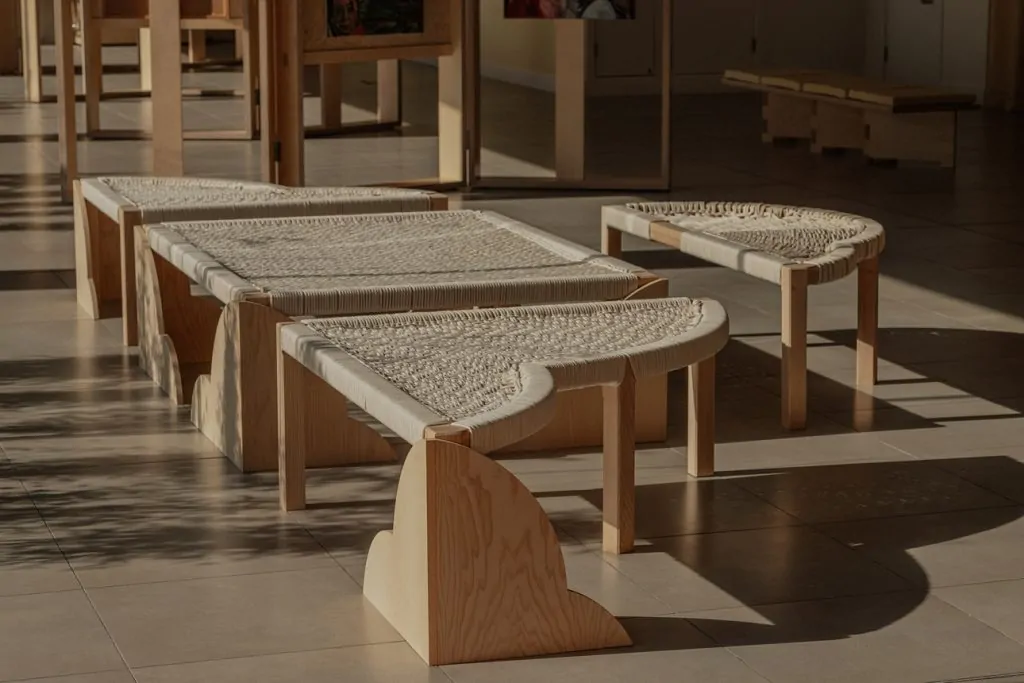
Courtesy without SHAPE without FORM
Your PhD, “Cultural Dysphoria: British Asian women artists beyond binaries”, challenges fixed ideas of identity. How does this research feed into your studio practice, and how does making reshape your theoretical lens?
Roo Dhissou: The research and the studio are the same conversation held in different rooms. Writing lets me test language for experiences that are messy, relational and sometimes inarticulate. Making lets me test those ideas with the body, with materials, with time and with other people. In the studio, I learn where theory is thin; a sentence that feels airtight on the page can fall apart when you try to weave, cook, stage, or invite people to inhabit it. That collapse is generative. It sends me back to the text with better questions.
The PhD gives me methods for noticing: I map how belonging is produced, where it frays, and what practices repair it. The studio provides me methods for hospitality: I turn those observations into spaces that people can rest in, learn in and make their own. Each side keeps the other honest. If an argument cannot be felt, I keep working. If an artwork cannot be thought with, I keep listening.
I’m also tired of institutions repeating the same old scenarios. Although a lot of this rhetoric is to do with funding agendas, I am saddened that some places use the same logic to commission. By this I mean commissioning South Asian artists to respond to briefs about South Asian things, as if that is all we are allowed to do. I dream of art infrastructures we haven’t yet tested or played with.
I don’t believe we’re post anything — postcolonial or postmodern. We are living in a turbulent time where thinkers and activists have long asked for more entangled ways to move forward: approaches that hold complexity and celebrate our gains while still challenging the binary logics often presented through Western art systems.
This is what both the practice and the PhD make possible: to prototype new ways of working that honour the shoulders we stand on while refusing the limits we’ve inherited through art history and colonialism. The theory needs the practice and the practice needs the theory, but they don’t illustrate each other.
You often describe your work as being rooted in “cultural dysphoria.” Could you expand on that term? How does it differ from the more familiar idea of “cultural hybridity,” and what kinds of
experiences does it better capture?
Roo Dhissou: A note on terms: I will define cultural dysphoria here for this piece. My PhD is due for completion in March 2026, so I am mindful about sharing expansions yet, but I am excited to share my research once it is complete. My working definition builds on the thinking of the non-
binary scholar Ayesha Sharma.
I believe cultural hybridity as a framework is becoming redundant in our current times. Hybridity describes a mixture at the description level: two or more lineages meeting in one body, one room, one sentence yet no space for the complexity that emerges. It’s not enough. Cultural dysphoria names how that mixture feels when it does not sit evenly. It is a somatic, relational experience of being out of tune with the categories meant to hold you: the tick-box that cannot contain you, the gallery context that misreads you, the family script that no longer fits. I do not
use the term as pathology, but as a barometer. It points to friction, which is also where repair can begin.
Dysphoria is temporal and situational. It can spike in small, ordinary moments: translation fatigue at the dinner table, the heat of being hypervisible and invisible in the same meeting, the catch in the throat when a word exists in one language but not the other. It can also ease. I pay attention to practices stabilising the nervous system and re- tuning the self: riyaz, cooking, weaving, sangat, breath. These practices do not fix identity; they give it rhythm. Fixing identities into taxonomies is a colonial practice. I ask for more self-determination, complexity, and entanglement.
Hybridity is often aestheticised, celebrated as a seamless blend or a tidy third space. Cultural dysphoria keeps power and infrastructure in view. It asks what conditions make belonging possible today, and who builds and maintains them. In my work, that becomes a method for
creating objects, space, time and moments. So the difference is practical as much as conceptual. Hybridity names the mix; dysphoria tracks its weather.
It helps me locate hurt without collapsing into harm, and to make forms that move people from dissonance toward alignment with whatever form of self they wish to inhabit, sometimes only for a few breaths, which is still enough to begin.
Your practice moves fluidly between sculpture, cooking, performance and publishing. What do these shifts in medium allow you to express about diaspora and community that a single discipline might not?
Roo Dhissou: I do not make work about anything. My work asks questions. It does not try to answer what it cannot comprehend. If I had the answers, I could stop making the work now. The practice is a lifelong pursuit, a lifelong practice.
Diaspora is multilingual in both sense and language. A single discipline often compresses that range. Shifting mediums lets me tune form to need: sculpture and installation remake the room so care is structural, not decorative; cooking translates ideas through taste, warmth and routine; performance tests ethics in real time with other bodies; publishing carries the work home so it can keep working quietly.
Each medium opens a different timescale. Clay dries slowly and teaches patience. A meal has a clear arc from preparation to clearing, which models collective labour and reciprocity. A live event makes attention visible and shared. A small publication has a long tail and lets people re-read, annotate and pass it on. Together, these rhythms show that community is not a moment but an infrastructure of ongoing acts.
Medium also shifts who gets to author the work. A table laid for langar invites many hands and voices. A woven bed asks people to rest, a form of participation. A booklet invites readers to become co-thinkers. By moving across tools, I can design multiple entry points so people with different literacies feel welcome: the cook who reads through taste, the reader who learns through text, the child who learns through touch.
So the movement is not eclecticism for its own sake. It is a method for making the questions legible. The form follows the relation I am trying to build: shared attention, repair, hospitality, and use. When those values are embedded in material choices, the work can hold more of what diaspora actually feels like: to live in more than one register at once and keep asking together.
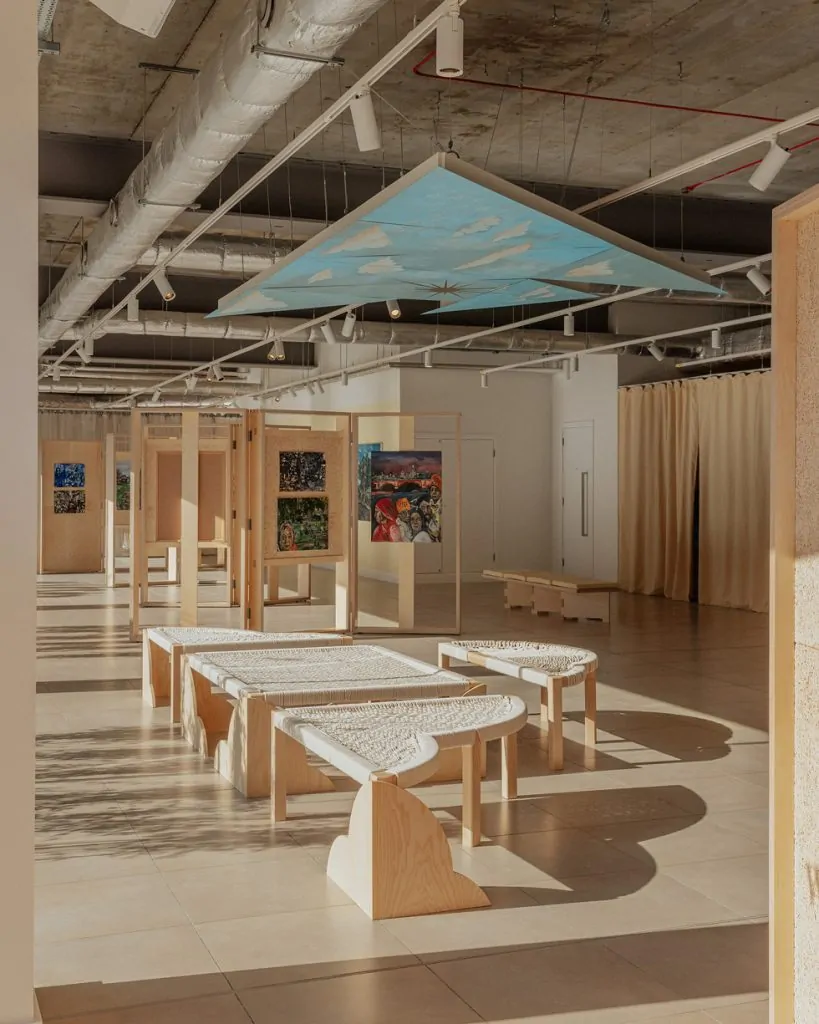
Courtesy without SHAPE without FORM
Objects such as the Sikh langar thali recur in your work. What makes this object such a powerful vehicle for exploring memory, hospitality and cultural resilience?
Roo Dhissou: For me, the thali is resilient because it aligns ethics, material and use. It is not a prop. It is a tool that keeps the community alive: a small, sturdy technology for practising equality, sharing labour, and remembering that nourishment is collective.
Using ceramics in this case carried its own labour and care, when I filled them with food when sharing dinners with many other artists in my immediate communities, through projects like Courses for Dis-Course(s), I saw the care and attention people took when passing these around. The slow approach is embodied in the clay as the trays were fragile and handmade personally, people couldn’t help but take care because they felt honoured to each out vessels that were crafted specifically for them and that moment.
There was care when washing, filling, and even eating out of them. I think this materiality explores memory, hospitality and resilience. Clay itself has its own memory. Each clay slab, during the process of its making, was embedded into a steel thali to take on its shape and memory. This was its foundation, and whilst I was inspired by Langar, it would be foolish to call this practice Lanagr.
Langar is much more phenomenal and can’t be translated into English. It’s not just free food served for others. In making an attempt, I’d say it was a philosophy of equality, of sharing, of daily maintenance and care, and it’s not just about the food or the tray but the way in which we eat, commune, pray and hold space together in the kitchen too.
I’d say this practice takes place as the Guru Granth Sahib is its witness, so in Gurdwara’s or specific sikh cermonies.
Heal, Home, Hmmm, your sculptural pavilion for the V&A and London Design Festival, took your practice into a highly public and architectural space. How did you conceive of a pavilion as a
form of storytelling about diaspora and identity?
Roo Dhissou: I do not make work about diaspora or identity. My work asks questions and builds conditions where we can practise answers together. It’s a common misconception that those from the diaspora make work about diaspora. I do so much more, I just happen to also be a complex diaspora with immigrant parents and I happen to have been raised in Punjab.
Heal, Home, Hmmm is not storytelling. It is a live inquiry into access, care and material responsibility.
I chose clay excavated from HS2 sites and traditional mud techniques for a reason. Clay is what many of us interact with daily without really being present. From the ground we stand on, to the toilets we use, the vessels we eat from, the ones we grow from, clay is living and fertile and when fired is strong and foundational. The methods I’ve used are low energy, repairable and collective. I have not fired any of the clay; it’s in its natural form. If a crack appears, I can mend it with water, fibre and time. That ethic of repair models the social care I believe in: maintenance rather than disposability, participation rather than passive viewing.
A recent materials journey with CIVIC Square and Material Cultures gave me practical skills and the confidence to imagine rebuilding a home I cannot access. My childhood memories of Punjab are full of mud houses, tandoor ovens and chuleh (clay ovens). Working with earth lets me translate those memories into forms that are usable now, not as nostalgia but as technique.
I also live with chronic immune and respiratory conditions. Clay housing is a breathable material. It moves moisture, regulates heat, and feels alive. Heal, Home, Hmmm asks a simple question with large consequences: what would the UK housing crisis look like if we remembered how to build for disassembly and return to soil, rather than demolition and waste? How do we build with planetary and human health in mind, so that material justice, health and social justice meet in that question?
This project is also a practice of remembering. Contemporary life taught me to forget the possibilities of soil and straw, mud and cow dung, timber and my own hands. I am learning again. I am trying to make artworks that can be composted or taken apart after our lifetime to challenge museum and gallery conservation so works are allowed to return to the earth or complete their life rituals. I want to preserve the earth, the animal kingdom, and put health and wellbeing before collection and preservation of objects and histories. We must look to the future!
Everything is entangled. Material justice is not a single issue, so it cannot have a single-issue solution. How do we host artists with access needs, disabilities and chronic illness while also creating space for environmental responsibility? This has been my insurance when working with the V&A.
Using clay from a major infrastructure project is part of that entanglement too. Such projects disturb land and communities. Transforming spoil into shelter is a way to meet disturbance with responsibility rather than denial. The pavilion is collaborative from sourcing to sound. Access is not only ramps and labels, although those matter. It is also about who gets to design, build and voice a space.
Ultimately, the work argues for an ecology of care. Materials can return to the ground. Structures can be patched and kept. Programmes can hold people as much as they hold objects. The pavilion was co-designed with Intervention Architecture and the clay came from Rescued Clay. Doing this work is communal and takes many bodies. Without them I have nothing. We rely on these connections — nothing is achieved alone.
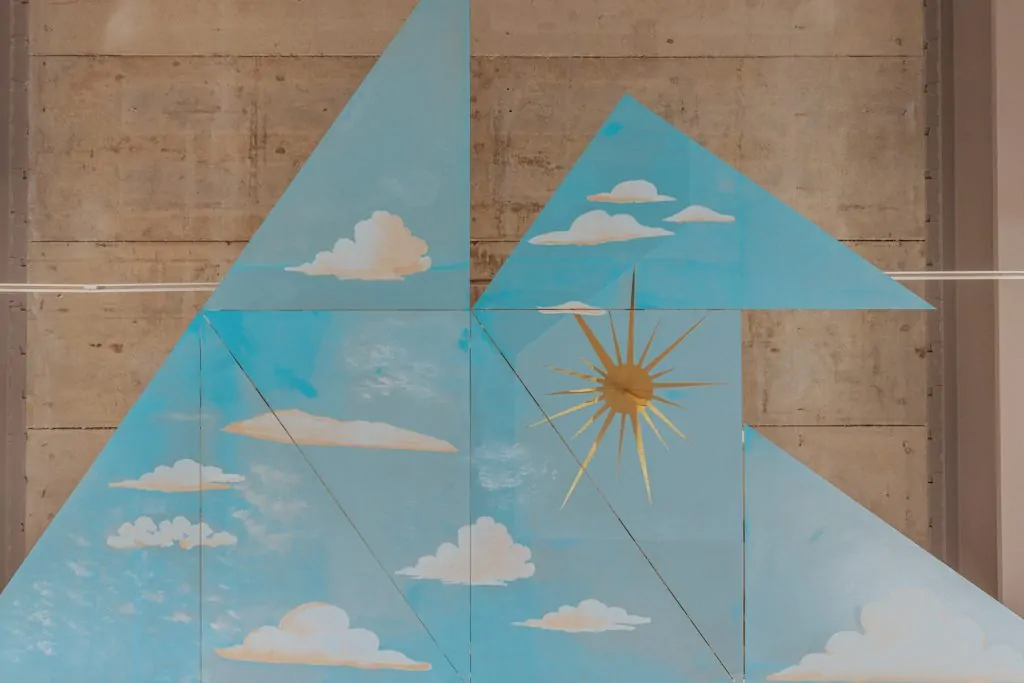
Courtesy without SHAPE without FORM
You have exhibited widely in Britain and internationally. Do you notice differences in how audiences outside the UK respond to work rooted in British South Asian experience?
Roo Dhissou: Of course, there are differences, but the deeper issue is the frame. My PhD looks at British South Asian women artists beyond binaries. The UK art scene still often sorts us into narrow groupings and reads practice primarily through identity.
I do not make work about identity. I build conditions for people to gather, ask questions, and practise care together. When the lens is fixed on a category, the practical ethics of
the work can be missed.
Outside the UK, people often enter through materials and hospitality first. Materials and media for me are food, craft, architecture, gathering, activist frameworks, and places to rest. The ethics become legible through their use. In Britain, there can be faster recognition of context, but also an overfamiliarity that flattens nuance. My aim in both settings is the same. Set clear invitations, slow the pace, and make structures where more than one reading is possible.
This is exactly what my research argues for: a move beyond binary frames. I hope we can attend to method and infrastructure as much as to image. When audiences meet the work as a set of practices, not as a statement about identity, the larger questions come into view: How do we host well? How do we repair? How do we redistribute attention and care? If the practice is about anything, then it’s the latter.
Winning the Serpentine’s Support Structures for Support Structures award in 2024 recognised artists at the intersection of social justice and visual art. How do you negotiate the tension
between activist intention and artistic autonomy?
Roo Dhissou: I begin with responsibility to the people who enter the work. I measure success by whether a space holds them well, not by whether it performs the correct slogans. Hammad Nasar asks me regularly how do you host when you’re not there with the work everyday. It’s
something troubling but I think these two works in this show attempt to do so, host without being there. The activist intention lives in structure and process.
It lives in materials that are low energy and repairable, in spaces that let people breathe, in accessible budgets, fair pay, transparent governance, and a plan for maintenance and afterlife
so the work does not vanish when the event ends.
Artistic autonomy comes from staying faithful to the form the work needs. Sometimes that form is quiet, slow, domestic, or awkward. I protect the right of the work to be a room for encounter rather than a message. I also design for use and for action: a well-held conversation, a table for repair and conflict, a bed that invites rest, a publication that circulates how it all came to be.
These are small, durable changes. They let politics sit in verbs rather than nouns. So I do not separate activism from art. I embed ethics in the invitations, in who is invited to build and be paid, in how attention is distributed, and in what remains with a community afterwards.
Autonomy is the freedom to refuse spectacle when spectacle would harm the work, and to make something useful when usefulness serves the people present. If a project can hold people with dignity and redistribute care, the politics are already doing their work.
In Reflections – Sangat and the Self, your work enters into dialogue with Jasmir Creed’s paintings of alienation and belonging. How do you see your practices meeting, and where do they diverge?
Roo Dhissou: We meet in a shared attention to relation. Her paintings trace the psychic weather of belonging and estrangement. My installations shape the social weather of a room. Her images invite interior reflection and sustained looking. My structures invite bodily rest, conversation and collective presence. Both ask what a person needs to feel whole, and how sangat can support that.
We diverge in method. Jasmir works through image, gesture and the eye. I work through materials, gatherings and architectures of care that involve the whole body (I’m sure painting is bodily but I refer aesthetics and context here as the main definers). Together, the exhibition offers two routes to the same questions, one through image, one through use.
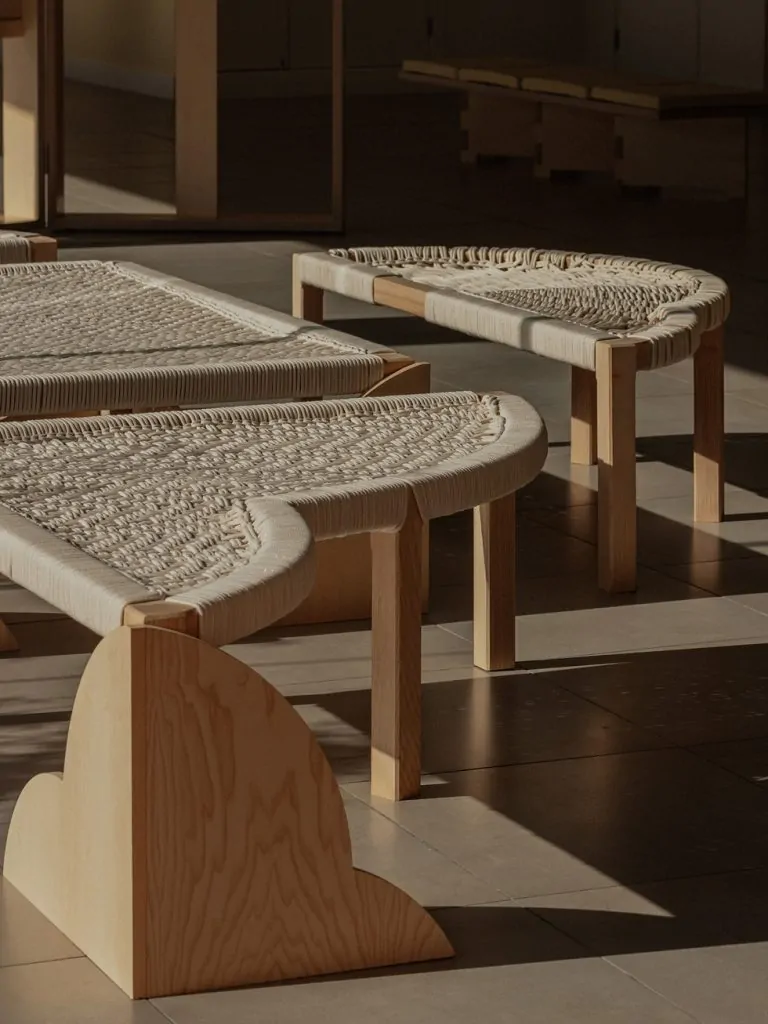
Courtesy without SHAPE without FORM
Care, cooking, and craft are key strategies in your practice. Do you see them primarily as metaphors for community and solidarity, or as embodied practices in their own right?
Roo Dhissou: They are always embodied first. The metaphor can come later. Cooking teaches timing, listening and trust. Craft trains attention, patience and repair. Care is not decoration; it is infrastructure. When these practices are taken seriously, people feel seen, rooms become
kinder, and decisions slow to a human scale. I do not mean this in a neat, neoliberal way. Many perform these words.
It is more complicated. I make mistakes, and I do not always get it right. That is why it is a practice. I keep learning, being guided by others, and working so our collectivity can hold our differences too. I do not do it alone; we do it for one another. If you want to hear that complexity, have a listen to my podcast Courses for Dis-Course(s). I work on both levels at once: real tools that do real work, and forms that carry meanings that travel.
At its core, what does being an artist mean to you? Beyond the works you create, how does art shape the way you live, reflect and move through the world?
Roo Dhissou: Being an artist is a way of paying attention and a way of hosting. I build conditions where people can meet, rest and think together, and I try to live by the same ethics that shape those rooms. Repair what you can. Share what you have. Move at the speed of care. Leave things
better than you found them.
As a child, I built small worlds from left over scraps and waste from my dad’s shop. Now I build them at larger scales, for my communities and for the past and future versions of myself who still need them. The practice does not chase answers. It holds durable questions and turns them into structures you can inhabit. Art keeps me in conversation with land, lineage and the everyday
sacred, and it helps me practise the worlds I want to see.
©2025 Roo Dhissou


